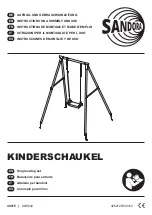
6
Preventing Baby’s Head from Flattening
Prévenir le risque d’aplatissement de la tête de bébé
Pediatricians and child health organizations
agree that healthy babies should be placed
on their backs to sleep for naps and at
nighttime, to reduce the risk of Sudden Infant
Death Syndrome (SIDS). But babies who are
always on their backs can sometimes develop
flat spots on their head (plagiocephaly).
Most cases of positional plagiocephaly can
be prevented (and sometimes corrected) by
repositioning your baby to relieve pressure on
the back of the head. Here are some tips and
techniques from the experts to keep in mind
as you care for your baby:
• Change the location of your baby’s crib in
the room, so she has to look in different
directions to see the door, or the window,
or interesting things going on around her.
• When your baby is awake, provide
opportunities for adult-supervised “tummy
time” play. Playing on his tummy helps
take the pressure off the back of his head,
which will help prevent flat spots from
developing. Tummy time play also helps your
baby’s head, neck and shoulder muscles get
stronger as part of normal development.
• Try tummy time two or three times a day,
for short periods of time, until your baby
gets used to being on her tummy. Once your
baby begins to enjoy this position, try longer
periods of time or increase the frequency of
tummy time play.
• Help your baby avoid resting his head in
the same position all the time by frequently
changing the direction he lies in the crib. For
example, have your baby’s feet point toward
one end of the crib for a few days, and then
change the position so his feet point toward the
other end of the crib. This will encourage your
baby to turn and look in different directions.
• Try to minimize the amount of time your
baby spends in car seats, carriers and
bouncy seats while awake.
• Lastly, make sure you enjoy lots of “cuddle
time” with your baby by holding her upright
over your shoulder.
• For additional information on positional
plagiocephaly and the benefits of tummy
time play for your baby, speak with your
pediatrician or family physician.
National Institute of Health (NIH) Eunice Kennedy
Shriver National Institute of Child Health and
Human Development
































